sensor MAZDA MODEL 3 HATCHBACK 2005 (in English) User Guide
[x] Cancel search | Manufacturer: MAZDA, Model Year: 2005, Model line: MODEL 3 HATCHBACK, Model: MAZDA MODEL 3 HATCHBACK 2005Pages: 322, PDF Size: 4.7 MB
Page 61 of 322
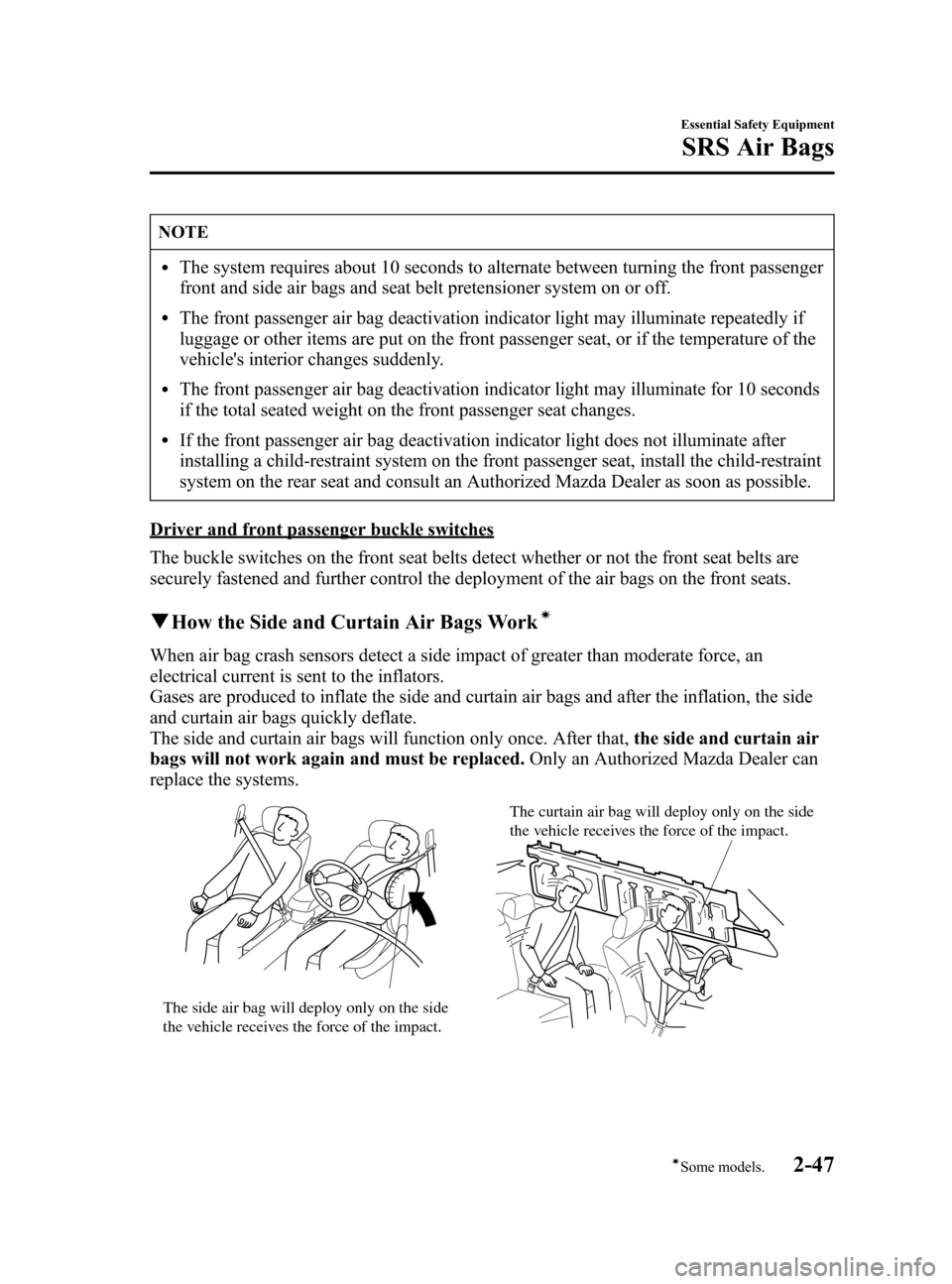
Black plate (61,1)
NOTE
lThe system requires about 10 seconds to alternate between turning the front passenger
front and side air bags and seat belt pretensioner system on or off.
lThe front passenger air bag deactivation indicator light may illuminate repeatedly if
luggage or other items are put on the front passenger seat, or if the temperature of the
vehicle's interior changes suddenly.
lThe front passenger air bag deactivation indicator light may illuminate for 10 seconds
if the total seated weight on the front passenger seat changes.
lIf the front passenger air bag deactivation indicator light does not illuminate after
installing a child-restraint system on the front passenger seat, install the child-restraint
system on the rear seat and consult an Authorized Mazda Dealer as soon as possible.
Driver and front passenger buckle switches
The buckle switches on the front seat belts detect whether or not the front seat belts are
securely fastened and further control the deployment of the air bags on the front seats.
qHow the Side and Curtain Air Bags Workí
When air bag crash sensors detect a side impact of greater than moderate force, an
electrical current is sent to the inflators.
Gases are produced to inflate the side and curtain air bags and after the inflation, the side
and curtain air bags quickly deflate.
The side and curtain air bags will function only once. After that,the side and curtain air
bags will not work again and must be replaced.Only an Authorized Mazda Dealer can
replace the systems.
The side air bag will deploy only on the side
the vehicle receives the force of the impact.The curtain air bag will deploy only on the side
the vehicle receives the force of the impact.
Essential Safety Equipment
SRS Air Bags
2-47íSome models. Mazda3_8T97-EC-04J_Edition1 Page61
Saturday, September 25 2004 2:8 PM
Form No.8T97-EC-04J
Page 62 of 322
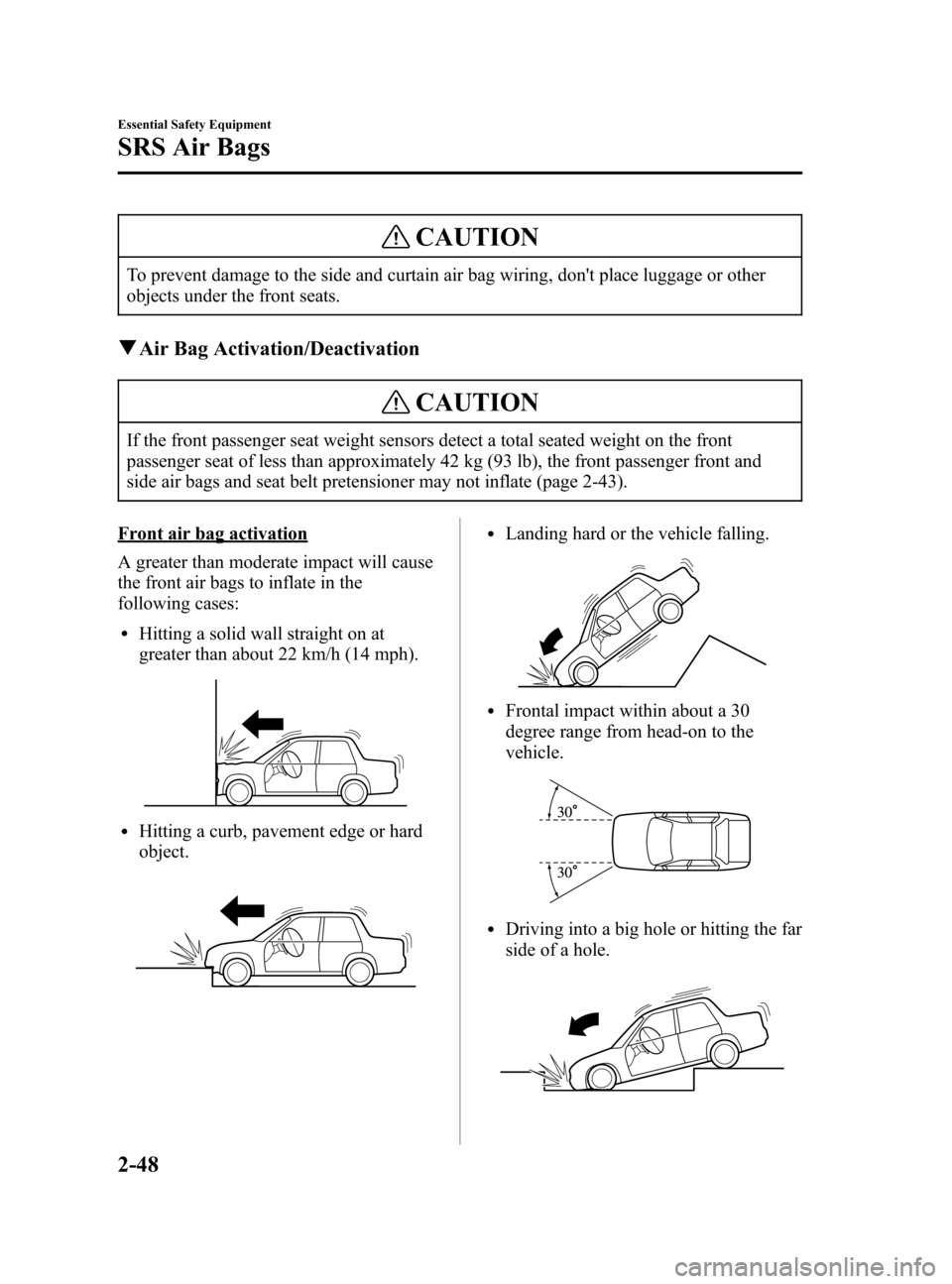
Black plate (62,1)
CAUTION
To prevent damage to the side and curtain air bag wiring, don't place luggage or other
objects under the front seats.
qAir Bag Activation/Deactivation
CAUTION
If the front passenger seat weight sensors detect a total seated weight on the front
passenger seat of less than approximately 42 kg (93 lb), the front passenger front and
side air bags and seat belt pretensioner may not inflate (page 2-43).
Front air bag activation
A greater than moderate impact will cause
the front air bags to inflate in the
following cases:
lHitting a solid wall straight on at
greater than about 22 km/h (14 mph).
lHitting a curb, pavement edge or hard
object.
lLanding hard or the vehicle falling.
lFrontal impact within about a 30
degree range from head-on to the
vehicle.
lDriving into a big hole or hitting the far
side of a hole.
2-48
Essential Safety Equipment
SRS Air Bags
Mazda3_8T97-EC-04J_Edition1 Page62
Saturday, September 25 2004 2:8 PM
Form No.8T97-EC-04J
Page 65 of 322
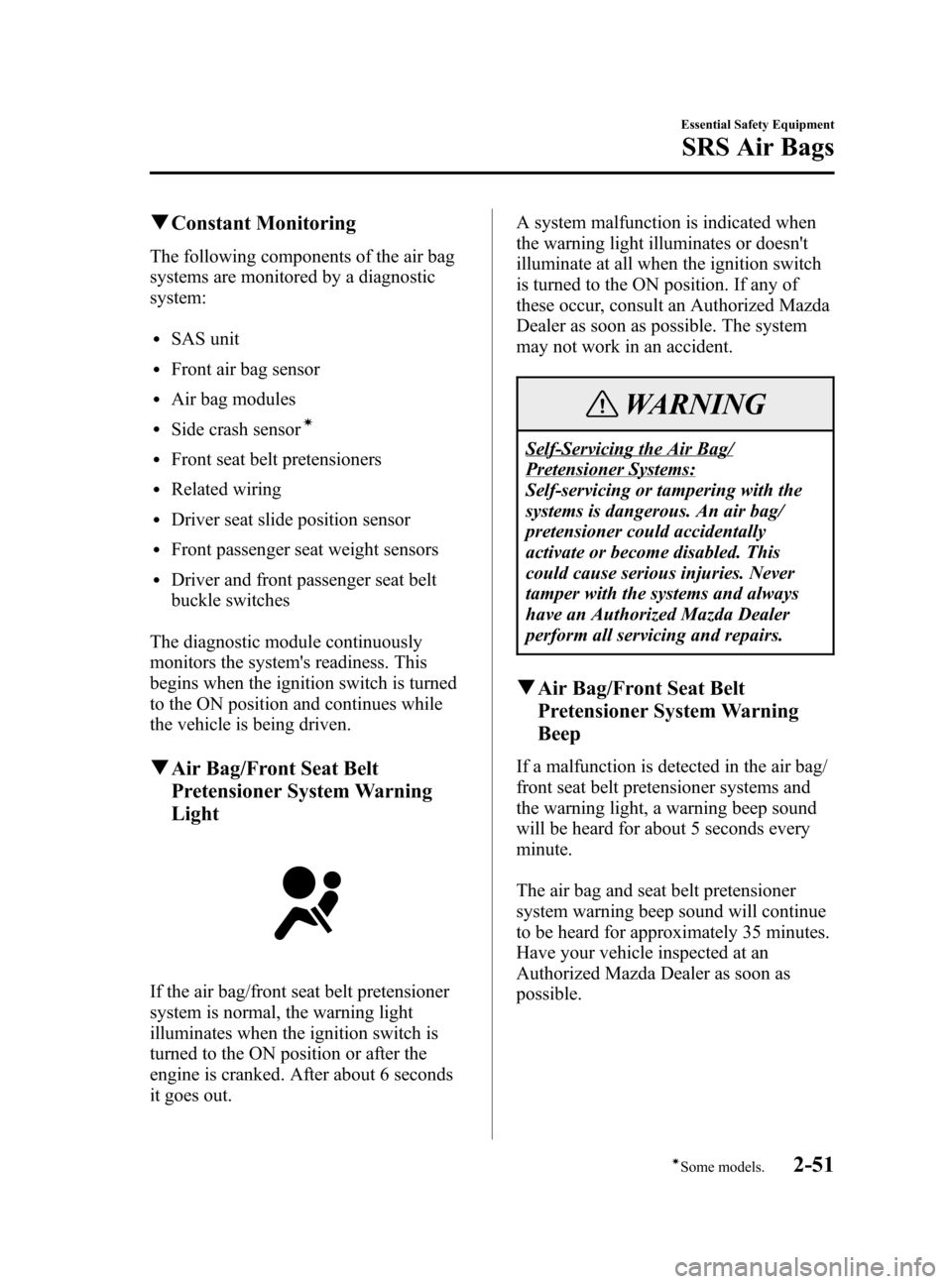
Black plate (65,1)
qConstant Monitoring
The following components of the air bag
systems are monitored by a diagnostic
system:
lSAS unit
lFront air bag sensor
lAir bag modules
lSide crash sensorí
lFront seat belt pretensioners
lRelated wiring
lDriver seat slide position sensor
lFront passenger seat weight sensors
lDriver and front passenger seat belt
buckle switches
The diagnostic module continuously
monitors the system's readiness. This
begins when the ignition switch is turned
to the ON position and continues while
the vehicle is being driven.
qAir Bag/Front Seat Belt
Pretensioner System Warning
Light
If the air bag/front seat belt pretensioner
system is normal, the warning light
illuminates when the ignition switch is
turned to the ON position or after the
engine is cranked. After about 6 seconds
it goes out.A system malfunction is indicated when
the warning light illuminates or doesn't
illuminate at all when the ignition switch
is turned to the ON position. If any of
these occur, consult an Authorized Mazda
Dealer as soon as possible. The system
may not work in an accident.
WARNING
Self-Servicing the Air Bag/
Pretensioner Systems:
Self-servicing or tampering with the
systems is dangerous. An air bag/
pretensioner could accidentally
activate or become disabled. This
could cause serious injuries. Never
tamper with the systems and always
have an Authorized Mazda Dealer
perform all servicing and repairs.
qAir Bag/Front Seat Belt
Pretensioner System Warning
Beep
If a malfunction is detected in the air bag/
front seat belt pretensioner systems and
the warning light, a warning beep sound
will be heard for about 5 seconds every
minute.
The air bag and seat belt pretensioner
system warning beep sound will continue
to be heard for approximately 35 minutes.
Have your vehicle inspected at an
Authorized Mazda Dealer as soon as
possible.
Essential Safety Equipment
SRS Air Bags
2-51íSome models. Mazda3_8T97-EC-04J_Edition1 Page65
Saturday, September 25 2004 2:8 PM
Form No.8T97-EC-04J
Page 66 of 322
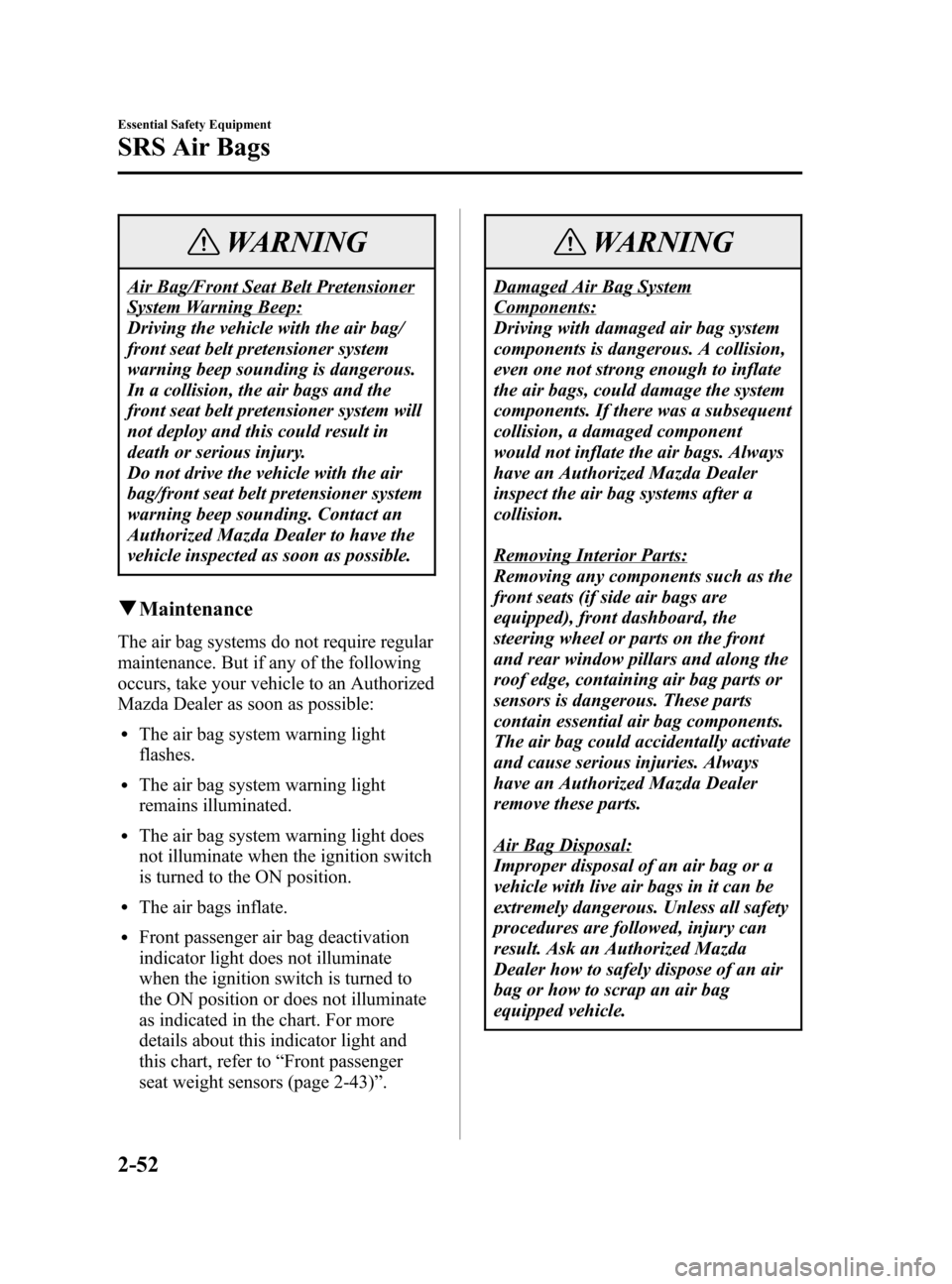
Black plate (66,1)
WARNING
Air Bag/Front Seat Belt Pretensioner
System Warning Beep:
Driving the vehicle with the air bag/
front seat belt pretensioner system
warning beep sounding is dangerous.
In a collision, the air bags and the
front seat belt pretensioner system will
not deploy and this could result in
death or serious injury.
Do not drive the vehicle with the air
bag/front seat belt pretensioner system
warning beep sounding. Contact an
Authorized Mazda Dealer to have the
vehicle inspected as soon as possible.
qMaintenance
The air bag systems do not require regular
maintenance. But if any of the following
occurs, take your vehicle to an Authorized
Mazda Dealer as soon as possible:
lThe air bag system warning light
flashes.
lThe air bag system warning light
remains illuminated.
lThe air bag system warning light does
not illuminate when the ignition switch
is turned to the ON position.
lThe air bags inflate.
lFront passenger air bag deactivation
indicator light does not illuminate
when the ignition switch is turned to
the ON position or does not illuminate
as indicated in the chart. For more
details about this indicator light and
this chart, refer to“Front passenger
seat weight sensors (page 2-43)”.
WARNING
Damaged Air Bag System
Components:
Driving with damaged air bag system
components is dangerous. A collision,
even one not strong enough to inflate
the air bags, could damage the system
components. If there was a subsequent
collision, a damaged component
would not inflate the air bags. Always
have an Authorized Mazda Dealer
inspect the air bag systems after a
collision.
Removing Interior Parts:
Removing any components such as the
front seats (if side air bags are
equipped), front dashboard, the
steering wheel or parts on the front
and rear window pillars and along the
roof edge, containing air bag parts or
sensors is dangerous. These parts
contain essential air bag components.
The air bag could accidentally activate
and cause serious injuries. Always
have an Authorized Mazda Dealer
remove these parts.
Air Bag Disposal:
Improper disposal of an air bag or a
vehicle with live air bags in it can be
extremely dangerous. Unless all safety
procedures are followed, injury can
result. Ask an Authorized Mazda
Dealer how to safely dispose of an air
bag or how to scrap an air bag
equipped vehicle.
2-52
Essential Safety Equipment
SRS Air Bags
Mazda3_8T97-EC-04J_Edition1 Page66
Saturday, September 25 2004 2:8 PM
Form No.8T97-EC-04J
Page 100 of 322
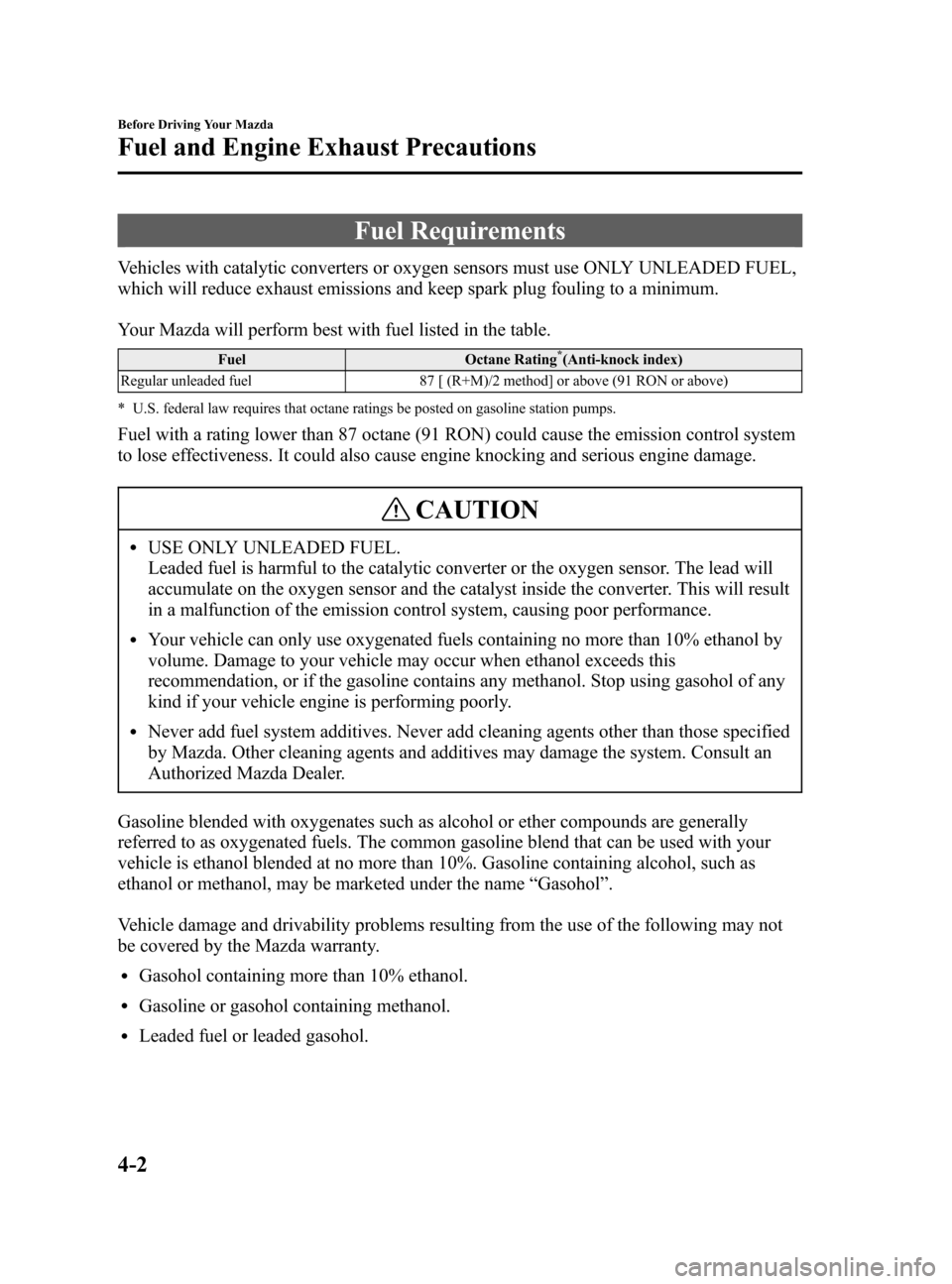
Black plate (100,1)
Fuel Requirements
Vehicles with catalytic converters or oxygen sensors must use ONLY UNLEADED FUEL,
which will reduce exhaust emissions and keep spark plug fouling to a minimum.
Your Mazda will perform best with fuel listed in the table.
Fuel Octane Rating*(Anti-knock index)
Regular unleaded fuel 87 [ (R+M)/2 method] or above (91 RON or above)
* U.S. federal law requires that octane ratings be posted on gasoline station pumps.
Fuel with a rating lower than 87 octane (91 RON) could cause the emission control system
to lose effectiveness. It could also cause engine knocking and serious engine damage.
CAUTION
lUSE ONLY UNLEADED FUEL.
Leaded fuel is harmful to the catalytic converter or the oxygen sensor. The lead will
accumulate on the oxygen sensor and the catalyst inside the converter. This will result
in a malfunction of the emission control system, causing poor performance.
lYour vehicle can only use oxygenated fuels containing no more than 10% ethanol by
volume. Damage to your vehicle may occur when ethanol exceeds this
recommendation, or if the gasoline contains any methanol. Stop using gasohol of any
kind if your vehicle engine is performing poorly.
lNever add fuel system additives. Never add cleaning agents other than those specified
by Mazda. Other cleaning agents and additives may damage the system. Consult an
Authorized Mazda Dealer.
Gasoline blended with oxygenates such as alcohol or ether compounds are generally
referred to as oxygenated fuels. The common gasoline blend that can be used with your
vehicle is ethanol blended at no more than 10%. Gasoline containing alcohol, such as
ethanol or methanol, may be marketed under the name“Gasohol”.
Vehicle damage and drivability problems resulting from the use of the following may not
be covered by the Mazda warranty.
lGasohol containing more than 10% ethanol.
lGasoline or gasohol containing methanol.
lLeaded fuel or leaded gasohol.
4-2
Before Driving Your Mazda
Fuel and Engine Exhaust Precautions
Mazda3_8T97-EC-04J_Edition1 Page100
Saturday, September 25 2004 2:9 PM
Form No.8T97-EC-04J
Page 131 of 322
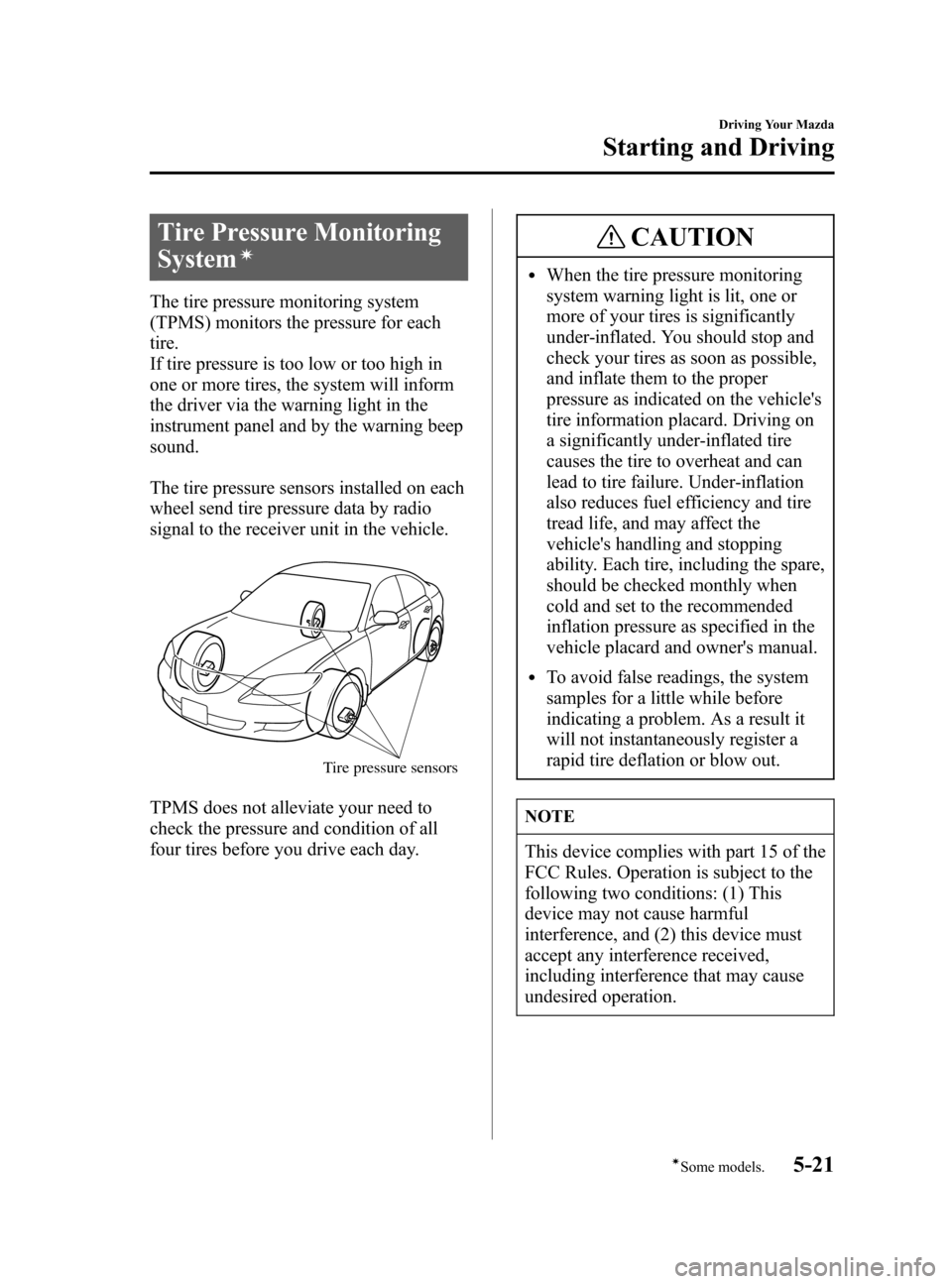
Black plate (131,1)
Tire Pressure Monitoring
System
í
The tire pressure monitoring system
(TPMS) monitors the pressure for each
tire.
If tire pressure is too low or too high in
one or more tires, the system will inform
the driver via the warning light in the
instrument panel and by the warning beep
sound.
The tire pressure sensors installed on each
wheel send tire pressure data by radio
signal to the receiver unit in the vehicle.
Tire pressure sensors
TPMS does not alleviate your need to
check the pressure and condition of all
four tires before you drive each day.
CAUTION
lWhen the tire pressure monitoring
system warning light is lit, one or
more of your tires is significantly
under-inflated. You should stop and
check your tires as soon as possible,
and inflate them to the proper
pressure as indicated on the vehicle's
tire information placard. Driving on
a significantly under-inflated tire
causes the tire to overheat and can
lead to tire failure. Under-inflation
also reduces fuel efficiency and tire
tread life, and may affect the
vehicle's handling and stopping
ability. Each tire, including the spare,
should be checked monthly when
cold and set to the recommended
inflation pressure as specified in the
vehicle placard and owner's manual.
lTo avoid false readings, the system
samples for a little while before
indicating a problem. As a result it
will not instantaneously register a
rapid tire deflation or blow out.
NOTE
This device complies with part 15 of the
FCC Rules. Operation is subject to the
following two conditions: (1) This
device may not cause harmful
interference, and (2) this device must
accept any interference received,
including interference that may cause
undesired operation.
Driving Your Mazda
Starting and Driving
5-21íSome models. Mazda3_8T97-EC-04J_Edition1 Page131
Saturday, September 25 2004 2:10 PM
Form No.8T97-EC-04J
Page 132 of 322
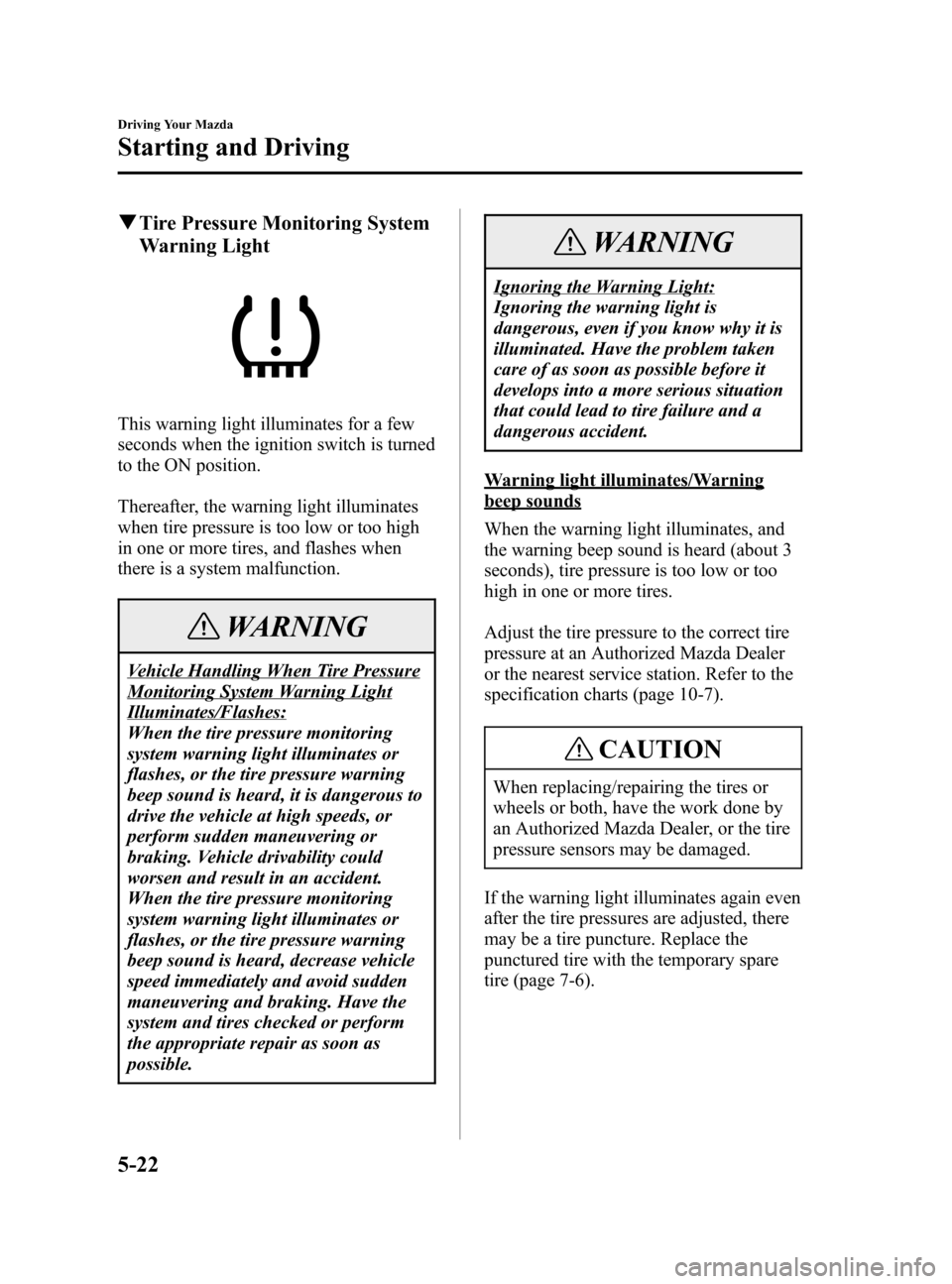
Black plate (132,1)
qTire Pressure Monitoring System
Warning Light
This warning light illuminates for a few
seconds when the ignition switch is turned
to the ON position.
Thereafter, the warning light illuminates
when tire pressure is too low or too high
in one or more tires, and flashes when
there is a system malfunction.
WARNING
Vehicle Handling When Tire Pressure
Monitoring System Warning Light
Illuminates/Flashes:
When the tire pressure monitoring
system warning light illuminates or
flashes, or the tire pressure warning
beep sound is heard, it is dangerous to
drive the vehicle at high speeds, or
perform sudden maneuvering or
braking. Vehicle drivability could
worsen and result in an accident.
When the tire pressure monitoring
system warning light illuminates or
flashes, or the tire pressure warning
beep sound is heard, decrease vehicle
speed immediately and avoid sudden
maneuvering and braking. Have the
system and tires checked or perform
the appropriate repair as soon as
possible.
WARNING
Ignoring the Warning Light:
Ignoring the warning light is
dangerous, even if you know why it is
illuminated. Have the problem taken
care of as soon as possible before it
develops into a more serious situation
that could lead to tire failure and a
dangerous accident.
Warning light illuminates/Warning
beep sounds
When the warning light illuminates, and
the warning beep sound is heard (about 3
seconds), tire pressure is too low or too
high in one or more tires.
Adjust the tire pressure to the correct tire
pressure at an Authorized Mazda Dealer
or the nearest service station. Refer to the
specification charts (page 10-7).
CAUTION
When replacing/repairing the tires or
wheels or both, have the work done by
an Authorized Mazda Dealer, or the tire
pressure sensors may be damaged.
If the warning light illuminates again even
after the tire pressures are adjusted, there
may be a tire puncture. Replace the
punctured tire with the temporary spare
tire (page 7-6).
5-22
Driving Your Mazda
Starting and Driving
Mazda3_8T97-EC-04J_Edition1 Page132
Saturday, September 25 2004 2:10 PM
Form No.8T97-EC-04J
Page 133 of 322
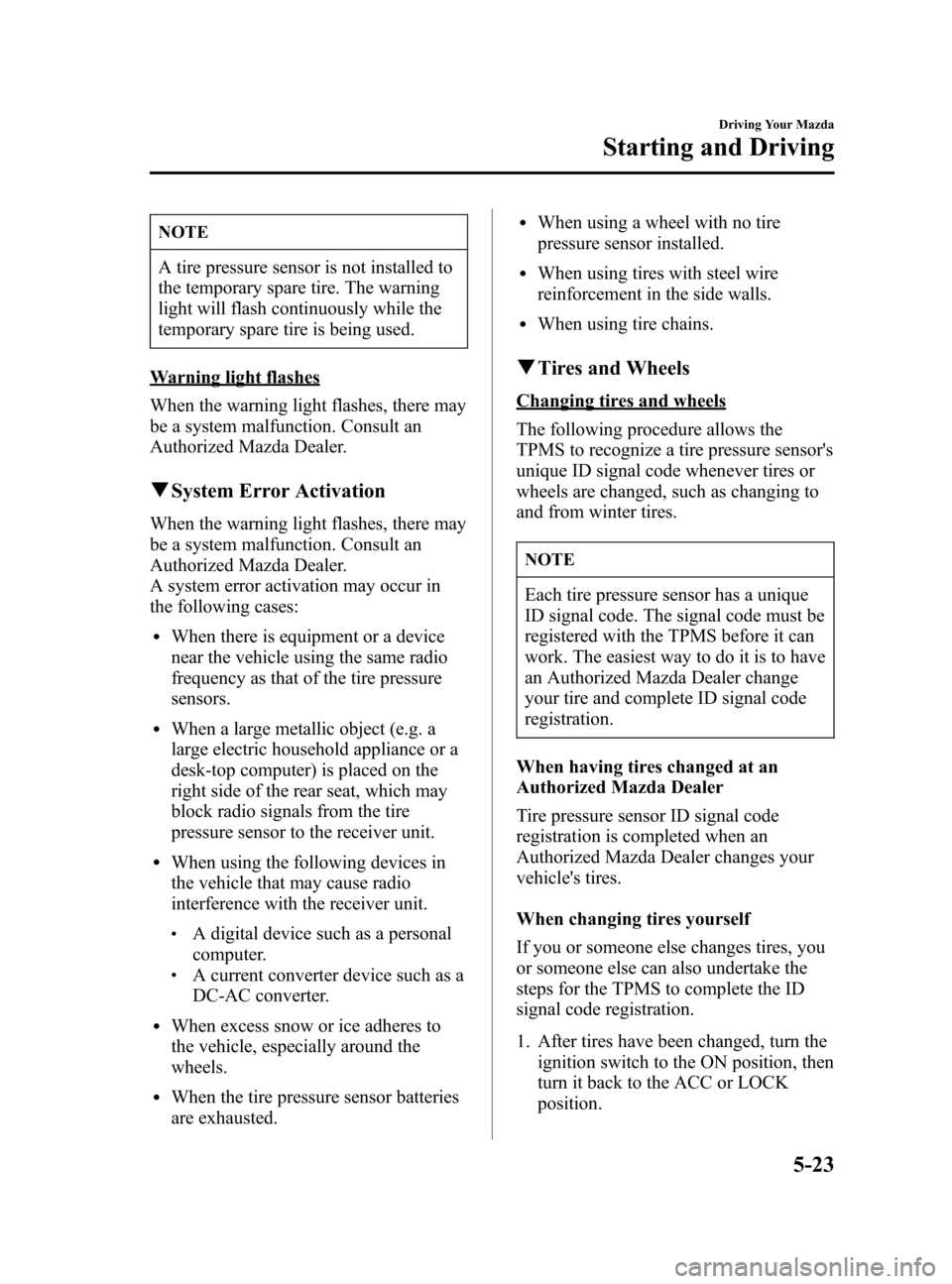
Black plate (133,1)
NOTE
A tire pressure sensor is not installed to
the temporary spare tire. The warning
light will flash continuously while the
temporary spare tire is being used.
Warning light flashes
When the warning light flashes, there may
be a system malfunction. Consult an
Authorized Mazda Dealer.
qSystem Error Activation
When the warning light flashes, there may
be a system malfunction. Consult an
Authorized Mazda Dealer.
A system error activation may occur in
the following cases:
lWhen there is equipment or a device
near the vehicle using the same radio
frequency as that of the tire pressure
sensors.
lWhen a large metallic object (e.g. a
large electric household appliance or a
desk-top computer) is placed on the
right side of the rear seat, which may
block radio signals from the tire
pressure sensor to the receiver unit.
lWhen using the following devices in
the vehicle that may cause radio
interference with the receiver unit.
lA digital device such as a personal
computer.
lA current converter device such as a
DC-AC converter.
lWhen excess snow or ice adheres to
the vehicle, especially around the
wheels.
lWhen the tire pressure sensor batteries
are exhausted.
lWhen using a wheel with no tire
pressure sensor installed.
lWhen using tires with steel wire
reinforcement in the side walls.
lWhen using tire chains.
qTires and Wheels
Changing tires and wheels
The following procedure allows the
TPMS to recognize a tire pressure sensor's
unique ID signal code whenever tires or
wheels are changed, such as changing to
and from winter tires.
NOTE
Each tire pressure sensor has a unique
ID signal code. The signal code must be
registered with the TPMS before it can
work. The easiest way to do it is to have
an Authorized Mazda Dealer change
your tire and complete ID signal code
registration.
When having tires changed at an
Authorized Mazda Dealer
Tire pressure sensor ID signal code
registration is completed when an
Authorized Mazda Dealer changes your
vehicle's tires.
When changing tires yourself
If you or someone else changes tires, you
or someone else can also undertake the
steps for the TPMS to complete the ID
signal code registration.
1. After tires have been changed, turn the
ignition switch to the ON position, then
turn it back to the ACC or LOCK
position.
Driving Your Mazda
Starting and Driving
5-23
Mazda3_8T97-EC-04J_Edition1 Page133
Saturday, September 25 2004 2:10 PM
Form No.8T97-EC-04J
Page 134 of 322
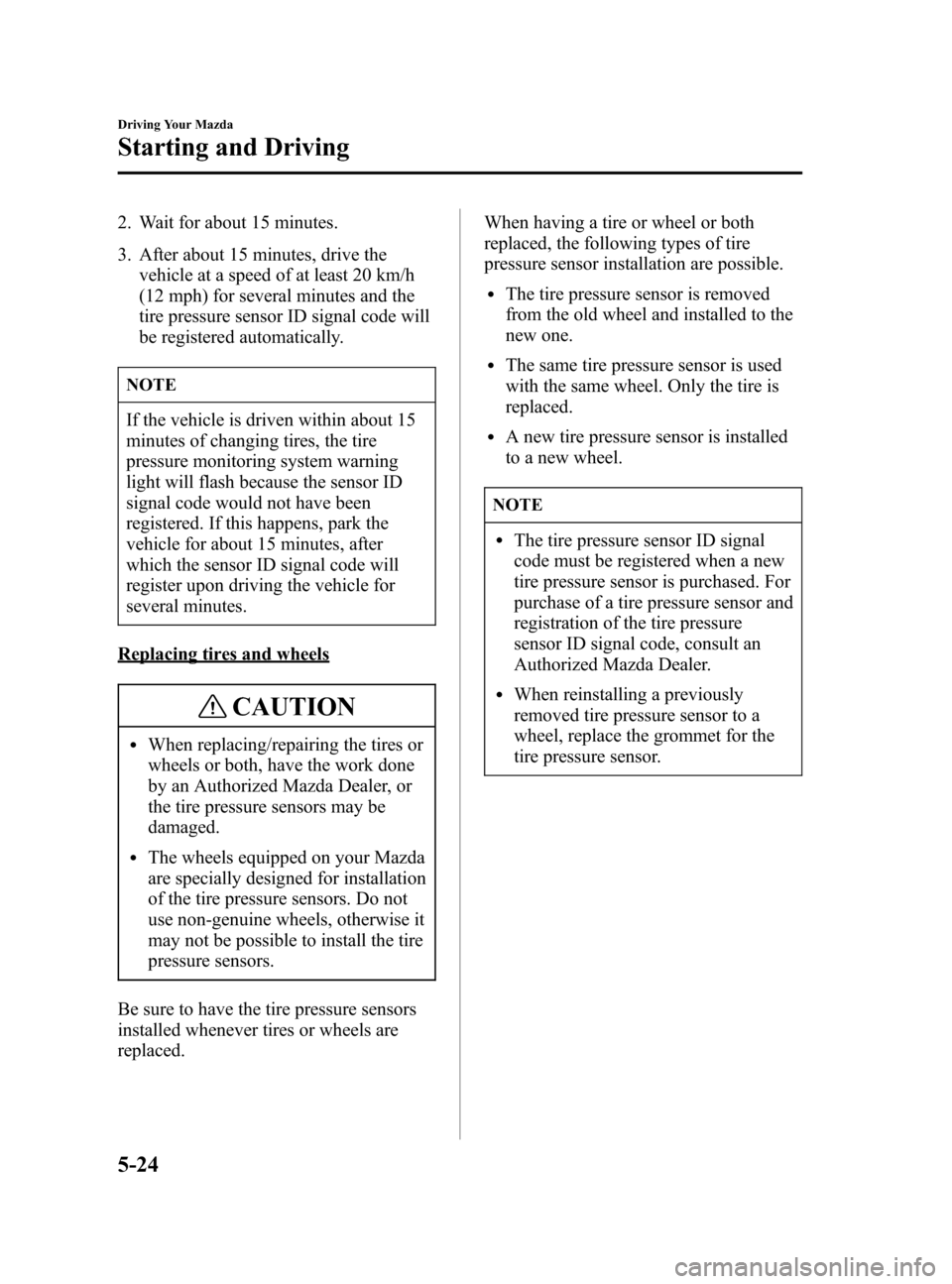
Black plate (134,1)
2. Wait for about 15 minutes.
3. After about 15 minutes, drive the
vehicle at a speed of at least 20 km/h
(12 mph) for several minutes and the
tire pressure sensor ID signal code will
be registered automatically.
NOTE
If the vehicle is driven within about 15
minutes of changing tires, the tire
pressure monitoring system warning
light will flash because the sensor ID
signal code would not have been
registered. If this happens, park the
vehicle for about 15 minutes, after
which the sensor ID signal code will
register upon driving the vehicle for
several minutes.
Replacing tires and wheels
CAUTION
lWhen replacing/repairing the tires or
wheels or both, have the work done
by an Authorized Mazda Dealer, or
the tire pressure sensors may be
damaged.
lThe wheels equipped on your Mazda
are specially designed for installation
of the tire pressure sensors. Do not
use non-genuine wheels, otherwise it
may not be possible to install the tire
pressure sensors.
Be sure to have the tire pressure sensors
installed whenever tires or wheels are
replaced.When having a tire or wheel or both
replaced, the following types of tire
pressure sensor installation are possible.
lThe tire pressure sensor is removed
from the old wheel and installed to the
new one.
lThe same tire pressure sensor is used
with the same wheel. Only the tire is
replaced.
lA new tire pressure sensor is installed
to a new wheel.
NOTE
lThe tire pressure sensor ID signal
code must be registered when a new
tire pressure sensor is purchased. For
purchase of a tire pressure sensor and
registration of the tire pressure
sensor ID signal code, consult an
Authorized Mazda Dealer.
lWhen reinstalling a previously
removed tire pressure sensor to a
wheel, replace the grommet for the
tire pressure sensor.
5-24
Driving Your Mazda
Starting and Driving
Mazda3_8T97-EC-04J_Edition1 Page134
Saturday, September 25 2004 2:10 PM
Form No.8T97-EC-04J
Page 148 of 322
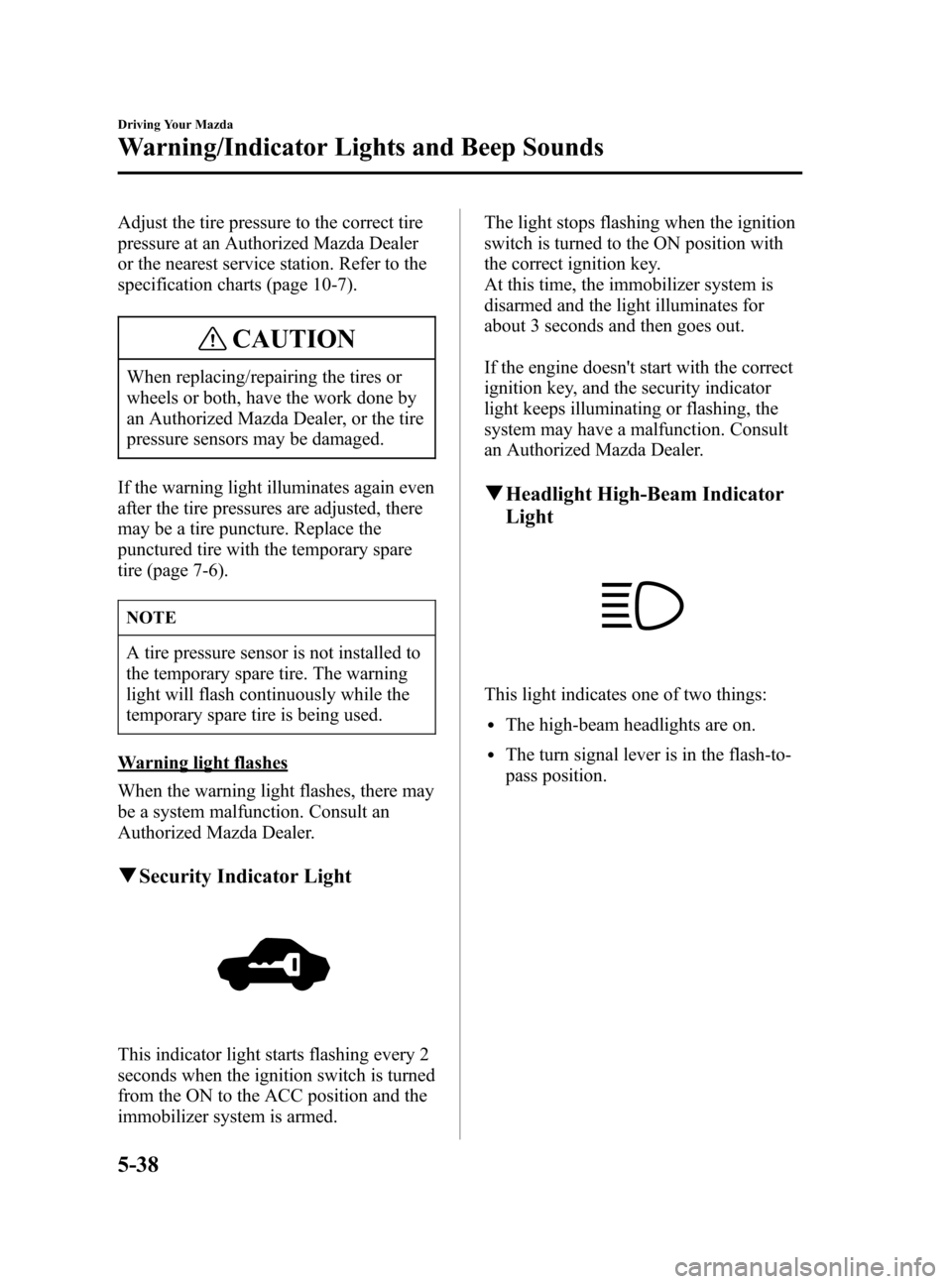
Black plate (148,1)
Adjust the tire pressure to the correct tire
pressure at an Authorized Mazda Dealer
or the nearest service station. Refer to the
specification charts (page 10-7).
CAUTION
When replacing/repairing the tires or
wheels or both, have the work done by
an Authorized Mazda Dealer, or the tire
pressure sensors may be damaged.
If the warning light illuminates again even
after the tire pressures are adjusted, there
may be a tire puncture. Replace the
punctured tire with the temporary spare
tire (page 7-6).
NOTE
A tire pressure sensor is not installed to
the temporary spare tire. The warning
light will flash continuously while the
temporary spare tire is being used.
Warning light flashes
When the warning light flashes, there may
be a system malfunction. Consult an
Authorized Mazda Dealer.
qSecurity Indicator Light
This indicator light starts flashing every 2
seconds when the ignition switch is turned
from the ON to the ACC position and the
immobilizer system is armed.The light stops flashing when the ignition
switch is turned to the ON position with
the correct ignition key.
At this time, the immobilizer system is
disarmed and the light illuminates for
about 3 seconds and then goes out.
If the engine doesn't start with the correct
ignition key, and the security indicator
light keeps illuminating or flashing, the
system may have a malfunction. Consult
an Authorized Mazda Dealer.
qHeadlight High-Beam Indicator
Light
This light indicates one of two things:
lThe high-beam headlights are on.
lThe turn signal lever is in the flash-to-
pass position.
5-38
Driving Your Mazda
Warning/Indicator Lights and Beep Sounds
Mazda3_8T97-EC-04J_Edition1 Page148
Saturday, September 25 2004 2:11 PM
Form No.8T97-EC-04J